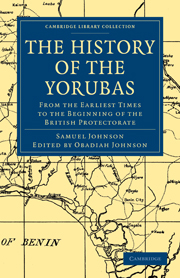Book contents
- Frontmatter
- AUTHOR'S PREFACE
- EDITOR'S PREFACE
- Contents
- 1 INTRODUCTION
- 2 THE YORUBA LANGUAGE
- 3 A SKETCH OF YORUBA GRAMMAR
- PART I THE PEOPLE, COUNTRY, AND THE LANGUAGE
- PART II
- CHAPTER I THE FOUNDERS OF THE YORUBA NATION
- CHAPTER II HISTORICAL KINGS
- CHAPTER III THE KINGS OF OYO IGBOHO
- CHAPTER IV A SUCCESSION OF DESPOTIC KINGS
- CHAPTER V BASORUN GAHA AND HIS ATROCITIES AND ABIODUN'S PEACEFUL REIGN
- CHAPTER VI THE REVOLUTION
- CHAPTER VII THE RISE OF THE FULANIS TO POWER
- CHAPTER VIII CONSEQUENCES OF THE REVOLUTION
- CHAPTER IX FURTHER DEVELOPMENT OF THE ANARCHY
- CHAPTER X SPREAD OF THE ANARCHY
- CHAPTER XI THE REVOLUTION IN THE EPO DISTRICTS
- CHAPTER XII WARS FOR THE CONSOLIDATION AND BALANCE OF POWER
- CHAPTER XIII THE LAST OF KATUNGA
- CHAPTER XIV THE INTERREGNUM
- CHAPTER XV THE NEW CITY, NEW GOVERNMENT, ILORIN CHECKED
- CHAPTER XVI FRATRICIDAL WARS
- CHAPTER XVII SUBJUGATION OF THE IJESAS AND EKITI'S SOCIAL REFORMS
- CHAPTER XVIII A GLORIOUS END AND A GORY DAWN OF TWO REIGNS
- CHAPTER XIX SEQUELS TO THE IJAYE WAR
- CHAPTER XX THE CLOSE AND THE OPENING CAREERS OF TWO HEROES
- CHAPTER XXI TWO ADMINISTRATIONS OF OPPOSITE POLICIES
- CHAPTER XXII A NEW REIGN AND EVIL PROGNOSTICATION
- CHAPTER XXIII THE COMMENCEMENT OF THE 16 YEARS' WAR
- CHAPTER XXIV CONFLICTS IN THE NORTH
- CHAPTER XXV IBADAN AT ITS EXTREMITY
- CHAPTER XXVI FAILURES AT RECONCILIATION
- CHAPTER XXVII A RIFT IN THE CLOUD
- CHAPTER XXVIII THE REV. J. B. WOOD AND THE A.O.K.
- CHAPTER XXIX THE INTERVENTION OF THE BRITISH GOVERNMENT
- CHAPTER XXX DISPERSAL OF THE COMBATANTS BY SPECIAL COMMISSIONERS
- CHAPTER XXXI DISTURBANCE IN EVERY PART OF THE COUNTRY
- CHAPTER XXXII ABORTIVE MEASURES TO TERMINATE THE WAR
- CHAPTER XXXIII THE DARK BEFORE THE DAWN
- CHAPTER XXXIV THE END OF THE WAR
- CHAPTER XXXV THE ESTABLISHMENT OF THE BRITISH PROTECTORATE. THE SEQUEL
- APPENDIX A TREATIES AND AGREEMENTS
- APPENDIX B
- INDEX
CHAPTER IX - FURTHER DEVELOPMENT OF THE ANARCHY
Published online by Cambridge University Press: 05 July 2011
- Frontmatter
- AUTHOR'S PREFACE
- EDITOR'S PREFACE
- Contents
- 1 INTRODUCTION
- 2 THE YORUBA LANGUAGE
- 3 A SKETCH OF YORUBA GRAMMAR
- PART I THE PEOPLE, COUNTRY, AND THE LANGUAGE
- PART II
- CHAPTER I THE FOUNDERS OF THE YORUBA NATION
- CHAPTER II HISTORICAL KINGS
- CHAPTER III THE KINGS OF OYO IGBOHO
- CHAPTER IV A SUCCESSION OF DESPOTIC KINGS
- CHAPTER V BASORUN GAHA AND HIS ATROCITIES AND ABIODUN'S PEACEFUL REIGN
- CHAPTER VI THE REVOLUTION
- CHAPTER VII THE RISE OF THE FULANIS TO POWER
- CHAPTER VIII CONSEQUENCES OF THE REVOLUTION
- CHAPTER IX FURTHER DEVELOPMENT OF THE ANARCHY
- CHAPTER X SPREAD OF THE ANARCHY
- CHAPTER XI THE REVOLUTION IN THE EPO DISTRICTS
- CHAPTER XII WARS FOR THE CONSOLIDATION AND BALANCE OF POWER
- CHAPTER XIII THE LAST OF KATUNGA
- CHAPTER XIV THE INTERREGNUM
- CHAPTER XV THE NEW CITY, NEW GOVERNMENT, ILORIN CHECKED
- CHAPTER XVI FRATRICIDAL WARS
- CHAPTER XVII SUBJUGATION OF THE IJESAS AND EKITI'S SOCIAL REFORMS
- CHAPTER XVIII A GLORIOUS END AND A GORY DAWN OF TWO REIGNS
- CHAPTER XIX SEQUELS TO THE IJAYE WAR
- CHAPTER XX THE CLOSE AND THE OPENING CAREERS OF TWO HEROES
- CHAPTER XXI TWO ADMINISTRATIONS OF OPPOSITE POLICIES
- CHAPTER XXII A NEW REIGN AND EVIL PROGNOSTICATION
- CHAPTER XXIII THE COMMENCEMENT OF THE 16 YEARS' WAR
- CHAPTER XXIV CONFLICTS IN THE NORTH
- CHAPTER XXV IBADAN AT ITS EXTREMITY
- CHAPTER XXVI FAILURES AT RECONCILIATION
- CHAPTER XXVII A RIFT IN THE CLOUD
- CHAPTER XXVIII THE REV. J. B. WOOD AND THE A.O.K.
- CHAPTER XXIX THE INTERVENTION OF THE BRITISH GOVERNMENT
- CHAPTER XXX DISPERSAL OF THE COMBATANTS BY SPECIAL COMMISSIONERS
- CHAPTER XXXI DISTURBANCE IN EVERY PART OF THE COUNTRY
- CHAPTER XXXII ABORTIVE MEASURES TO TERMINATE THE WAR
- CHAPTER XXXIII THE DARK BEFORE THE DAWN
- CHAPTER XXXIV THE END OF THE WAR
- CHAPTER XXXV THE ESTABLISHMENT OF THE BRITISH PROTECTORATE. THE SEQUEL
- APPENDIX A TREATIES AND AGREEMENTS
- APPENDIX B
- INDEX
Summary
EVIL DAYS FOR THE CAPITAL
Prince Amodó was one of the grandchildren of Ajampati the twin brother of King Ajagbó. He came to the throne at a time when the kingdom was distracted by anarchy and confusion. The Fulanis having an eye on the capital of Yoruba-land, but not being confident enough to make an attack on the city whilst there were so many powerful chiefs in the land, who might suddenly return to their allegiance, were using prudence and astuteness to spread the disaffection. They were fanning the flames of discord by allying themselves with one or other of the chiefs known to be rebellious against their lawful sovereign. None of the provincial kings now paid tribute to Oyo or acknowledged the authority of the King. He was virtually King of the capital only.
In order to have a powerful friend and ally in whom he could confide in time of emergency, King Amodó made an alliance with Lanloke the chief of Ogodo, a market town, at the confluence of the river Niger, where Yorubas and Tapas met for an exchange of merchandise. Ogodo was originally a Tapa town, but subsequently the Yoruba population predominated, nearly all the children of influential Oyo chiefs resided there permanently for the purpose of trade. King Amodó cemented and strengthened this alliance by giving his daughter to Lanloke to wife, and treating him as an independent sovereign.
- Type
- Chapter
- Information
- The History of the YorubasFrom the Earliest Times to the Beginning of the British Protectorate, pp. 217 - 222Publisher: Cambridge University PressPrint publication year: 2010First published in: 1921



